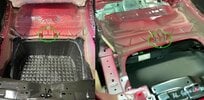you've misconstrued Munro's description.tangible1 - Did you not view the video I linked at all? It clearly shows two castings bolted together. In a Model Y.
you need to review pictures / diagrams of the rear casting.
In those, you will find that for the rear casting, there's a large 'bow' of empty space, which is filled by the large underbody chassis piece Munro describes as a 2nd casting.
Yes, it's a 2nd casting piece. It is common to all MY's,
But that piece covers the rear electric motor area and half-shafts. There is NO room underneath or in that area for a spare tire.
On top of that chassis piece rides the rear seating; it can be one row or two rows of rear seats.
No one refers to that overall assembly as a single piece casting.
The rear megacast is one piece. To that casting, the electric motor cover / floorboard is bolted, and also the rear crumple-zone bolsters (horns, braces, lots of terms for them).
You mixed your wishes with terminology caged from a video, out of context.
There's no room whatsoever for a spare tire in that area. Unless you wish to have no rear motor, or no rear trunk (and compromise crashworthiness).





